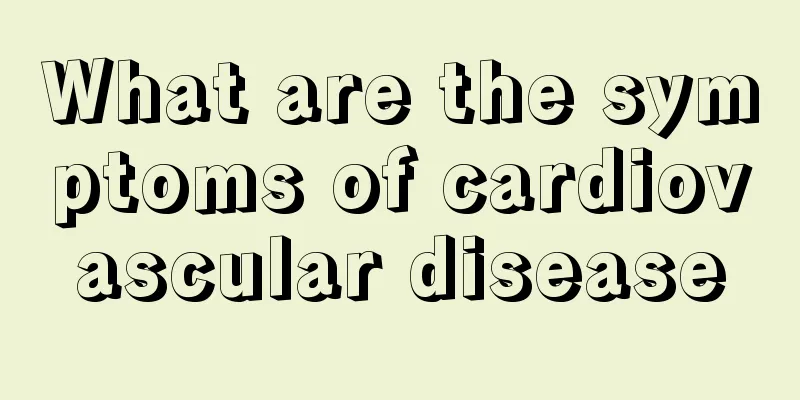What are the symptoms of cardiovascular disease

|
Cardiovascular disease is a common clinical disease. This disease has a great impact on human health and may often cause many complications. Patients must pay attention to cardiovascular disease issues. The clinical definition of cardiovascular disease is very broad, and many diseases fall into the category of cardiovascular disease. Generally speaking, the chances of developing cardiovascular diseases are higher in middle and elderly people, so we must pay attention to taking care of our bodies. Cardiovascular diseases have a wide range and their symptoms are also quite obvious. If patients have abnormal symptoms for a long time, timely measures must be taken. So what are the symptoms of cardiovascular disease? 1. Heart palpitations Palpitations are a combination of subjective feelings and objective signs Cardiovascular disease. Subjectively, the patient feels that the heart is beating fast, irregularly or forcefully. Objective examination can show that the heartbeat is too fast, too slow or irregular, that is, there are changes in heart rate and rhythm. 2. Difficulty breathing Dyspnea is also a comprehensive manifestation of subjective feelings and objective signs. Subjectively, breathing feels labored, and objectively, the number of breaths increases, and the movements become faster and larger in amplitude. Various organs in the chest can experience symptoms of breathlessness. Diseases such as cerebral infarction, pneumonia, acute pneumothorax, airway obstruction, chest wall muscle inflammation, rib fractures, and even pain from skin diseases such as herpes zoster can also lead to difficulty breathing. Heart disease Dyspnea caused by heart disease is often gradual and gradually worsens. 3. Paroxysmal nocturnal dyspnea It is also called "cardiac asthma" to distinguish it from asthma caused by lung disease. In addition to the above two points, the mechanism of occurrence is that the sensitivity of the respiratory center decreases after falling asleep, and lung congestion to a certain extent causes obvious hypoxia, causing the patient to wake up from his sleep and feel extreme difficulty in breathing. The patient needs to immediately change from a lying position to a sitting position or even a standing position, and the symptoms will gradually be relieved. 4. Acute pulmonary edema It is the most serious type of breathing difficulty, which can affect the patient's life and requires emergency treatment. The patient presented with extreme dyspnea, orthopnea, obvious hypoxia, and continuous coughing up of pink foamy sputum. 5. Cyanosis Cyanosis is a physical sign that refers to a bluish-purple discoloration of the mucous membranes and skin. Restores blood red in the body The absolute value of cardiovascular disease protein (hemoglobin not saturated with oxygen) exceeds 5g% (6~7vol% unsaturation). The mechanisms of cyanosis are hypoxic blood, excess hemoglobin, and blood stasis. There are two types: central type and peripheral type.
|
<<: What causes high risk of trisomy?
>>: What to do if your big toe hurts?
Recommend
What are the symptoms of myocardial infarction?
Myocardial infarction is actually a highly preval...
Is the cure rate for tongue cancer high?
In today's life, there are more and more type...
This method is the fastest way to treat herpes simplex virus
Herpes simplex virus is an infectious disease. If...
How to avoid damage to skin integrity in laryngeal cancer patients
Laryngeal cancer patients need to stay in bed for...
What does high-risk positive mean
High-risk positive means that the patient is foun...
Does nasopharyngeal carcinoma require targeted therapy?
Does nasopharyngeal carcinoma require targeted th...
What is the reason for lower back pain after uterine curettage
Curettage is a very common method of abortion, wh...
What is non-small cell lung cancer associated antigen? An examination of an indicator of lung cancer
If the values of non-small cell lung cancer rel...
Increased secretion is the main manifestation of uterine cancer
I believe everyone should know that uterine cance...
What's going on when my whole body feels numb and I have difficulty breathing?
As long as people are alive, they will breathe. T...
In what situations do you need a tooth filling
Nowadays, too many people do not have a healthy o...
Which hospital is best for osteosarcoma
Everyone is afraid of osteosarcoma, which is a li...
Is the swollen face due to toothache an inflammation?
Toothache is a very painful symptom. This pain is...
What to do if the heels have dry skin
Many people will find that they have dry skin on ...
Finding the cause of gallbladder cancer is the key
In recent years, the incidence of gallbladder can...









